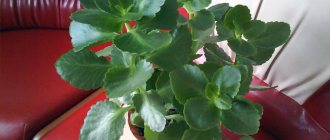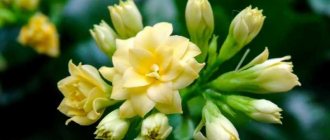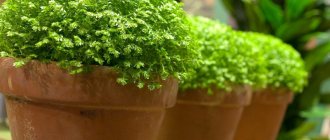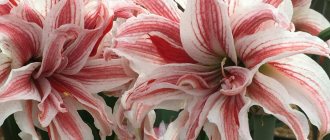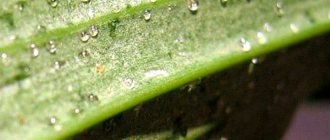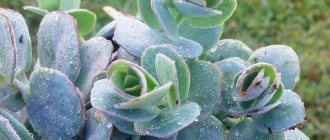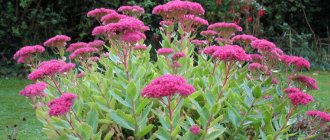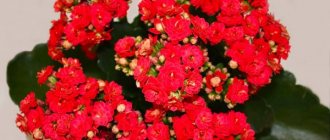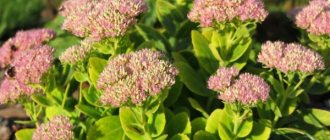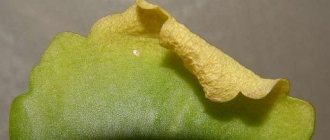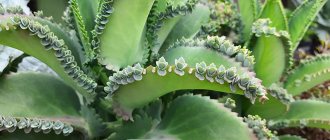Kalanchoe is a medicinal plant, unpretentious and easy to care for. It came to European latitudes from Africa and the Canary Islands. Tends to accumulate water, which contributes to survival in conditions of water deficiency. The stem can reach a height of more than one meter. Reproduces through leaves. It begins to bloom in winter with bright pink flowers. Kalanchoe does not like excess moisture, despite its tropical origin. It is watered so that the soil is moist, but not wet, and so that there is no water left in the pot.
Family doctor, or Kalanchoe doctor, as the flower is often called, is a very useful indoor plant. It does not require special care, and its benefits are more than enough.
What does it look like
What does medicinal Kalanchoe look like?
The most common indoor types:
- Kalanchoe Degremona. Reaches a height of 100 cm. It has triangular leaves, loves the sun;
- Kalanchoe Blossfeld. This species produces flowers. A more decorative variety than described above. The stem length is up to 30 cm. The leaves are round, the flowers are collected in a bunch. The variety prefers a shady place.
Degremona
Separation of root suckers
Only one species can be propagated in this way - Kalanchoe Blossfeld. After flowering is completed, the tip of the shoot is pinched to stimulate the development of offspring. As a result, young offspring appear near the mother flower.
The offspring must reach 1/3 the length of the adult plant
They are collected for breeding. After this, the offspring can be separated and planted in a pot with a sand-turf substrate (8 parts river sand, 2 parts sifted turf soil).
Healing properties of Kalanchoe
Kalanchoe: home care and main family species
The plant has watery leaves rich in juice. They contain the active substances for which Kalanchoe is so valued. The juice is used for medicinal purposes. In particular, the leaves of the plant contain enzymes and organic acids, as well as flavonoids - special substances that affect the tone of the heart muscle.
Leaves of Kalanchoe Blossfeld
One leaf of the plant contains:
- vitamin C and P;
- tannins;
- flavonoids;
- mineral salts;
- a variety of macro and microelements (copper, manganese, calcium, aluminum, potassium);
- organic acids, etc.;
- polysaccharides;
- silicon;
- iron;
- magnesium.
These microelements promote healing, soothe irritation and inflammation. Thanks to them, burns, wounds and frostbite can be treated.
For your information! In ancient times, the Kalanchoe plant was used as a medicine by many peoples. The famous poet I. Goethe once wrote to his friends: “Starting with one leaf, the Kalanchoe grows many new shoots, so with one true love you can draw new happiness.”
Also, Kalanchoe medicinal purifies the air and disinfects. That is why it is useful to keep it in homes where allergy sufferers live. In addition, it fights the flu virus and other infections.
Kalanchoe is used in gynecology (during childbirth, during reconstructive operations). In dentistry, it helps cure putrefactive bleeding.
In cosmetology, its juice is used to remove dark circles under the eyes, heal minor wounds after operations, and cracks. For problem skin, rubbing a few drops of juice into irritated areas (acne, inflammation, eczema) helps.
Kalanchoe juice is used in many areas. In particular, in:
- surgery, including plastic surgery. From the juice of the plant, there is an acceleration of the regeneration of skin properties, cleansing wounds of pathogenic organisms, as well as a local anesthetic effect;
- ophthalmology. In this area, Kalanchoe is used for diseases of the cornea, keratitis, etc.;
- dentistry. This plant is good for treating stomatitis, gingivitis, periodontal diseases, etc.
Kalanchoe has the following properties:
- antiseptic;
- anti-inflammatory;
- healing;
- bactericidal.
For your information! If the flower is cared for correctly at home, the healing properties of its juice are preserved. If the flower lacked something or the plant was damaged, the properties become less pronounced.
Kalanchoe - can you keep it at home: the meaning of the flower, signs and superstitions
A blooming Kalanchoe in an eco-bag is an excellent gift for all occasions.
Kalanchoe has medicinal qualities and is beneficial for humans. Therefore, be sure to get yourself this plant. It is quite patient and accepts minimal self-care with gratitude.
As for signs, they all have a positive meaning. Kalanchoe is not a magnet for dark forces, outbreaks of quarrels and abuse, diseases and troubles.
Vice versa:
- Kalanchoe absorbs heavy energy accumulated at the end of your working day
- cleanses the aura of the house, removes negativity from space
- promotes harmonization of family relationships
- encourages changing negative thoughts to positive ones
- brings the family together for pleasant conversations
- if your Kalanchoe blooms, it means that harmony, peace and harmony reign in the house
However, think about it if:
- your green pet suddenly began to fade and died, which means he took upon himself an external dark attack aimed at destroying the harmony of your family,
- it has been living with you for many years and does not bloom, which means there is a lack of sincerity, depth of relationships, and harmony in your family.
What does Kalanchoe treat?
Phalaenopsis orchid: main types and home care options
What Kalanchoe cures is a common question on the Internet. Here is a short list of diseases for which this representative of the flora helps:
- rhinitis;
- colds;
- inflammation of the mucous membrane of the nose and sinuses;
- healing of wounds and burns, the juice has restorative properties;
- bleeding;
- diseases of the digestive system.
Ointment
How to treat Kalanchoe for adults
Vanilla Orchid: main types and home care options
The Kalanchoe plant is actively used in folk medicine as a cure for many diseases. It can be compared to aloe, but the medicinal properties of Kalanchoe are the best way to combat viral diseases. The disease goes away much faster.
Based on Kalanchoe, the popular medicine Kalankhin was created, which is used in the treatment of gastroenteritis, burns, frostbite and cracked nipples of nursing mothers.
How to use Kalanchoe
The juice and leaves of the plant are used in different ways.
Kalanchoe for treating colds
To treat a runny nose, a decoction or juice of the leaves is used. Sometimes aloe and onion are added to it. In the latter case, it is very important to maintain the correct proportions.
Note! The therapeutic effect occurs when the nasal mucosa is slightly irritated, which leads to intense sneezing. In this way, a person gets rid of accumulated pathogenic mucus. For this reason, this plant is sometimes called "sneezer".
Before use, it is necessary to check whether a person is allergic to this plant. This is a very important point when using Kalanchoe juice. The plant can unnecessarily irritate the mucous membrane, thereby causing a deterioration in the patient's condition. But, if everything is done correctly and carefully, then a positive result is guaranteed. The mucus will come out of the sinuses, and the person will breathe easier.
Kalanchoe decoction
The uniqueness of the product lies in the fact that Kalanchoe officinalis is suitable for treating people of all ages.
You can get a medicinal decoction from Kalanchoe, for which you will need several leaves. They should be filled with 100 ml of water. Boil this mixture and cool completely. It is very important to use the decoction in small doses.
Plant juice
The easiest way is to simply squeeze the juice out of the leaves by squeezing them between your fingers. If the leaves are dry, they are first crushed and then carefully filtered through a bandage or gauze. You don't need a lot of juice, just 1-2 drops. For children under 2 years old, Kalanchoe juice is diluted with water. Sometimes you can even simply wipe the nasal cavity with a cotton swab dipped in juice.
Juice
Using nasal drops from Kalanchoe and aloe juice is very useful and effective. They are mixed in equal proportions in the amount of 1-2 drops of each plant. This medicine is the most gentle and gives a mild effect.
Important! If there is no allergy to Kalanchoe, the plant juice can be used as a preventative measure. During various epidemics, it is recommended to instill drops into the nose several times a day.
Why do Kalanchoe leaves turn yellow, curl, dry out and fall off?
Kalanchoe leaf tips dry out.
There are several reasons for this phenomenon, depending on the nature and location of the affected leaves.
- If these are only the top ones, then the plant does not have enough sun light.
- If only the lower ones - you allowed the soil to dry out and have not watered the Kalanchoe for a long time. And also, perhaps, there is a too hot battery under his pot. Therefore, change its place to a cooler one.
A few more reasons:
- tightness of the pot,
- the plant is aging, which means it’s time to pinch off its healthy shoots/leaves and take rejuvenation measures,
- infestation with aphids, if a similar situation occurs in the summer, and the plant itself lives on the balcony or in your garden.
Contraindications to the use of Kalanchoe
People with diseases of the liver, kidneys and joints should be more careful when treating Kalanchoe. There may be allergic reactions in nursing and pregnant women (during pregnancy it is generally advisable to refrain from treatment with this method).
Before use, it is better to consult a doctor, especially for people prone to allergies. Also, you should not use the plant juice for low blood pressure, tumors, or hepatitis.
Note! In its pure form, Kalanchoe is not suitable for children, because the child may have a burn to the nasal mucosa. It is best to test for allergic reactions before use to avoid unwanted effects.
All medications, even if they are natural, should be used after consultation with a doctor; this is a prerequisite for treatment.
Traditional medicine recipes
The leaves located as close as possible to the stem of the plant are best suited for preparing medicinal tinctures.
- Tincture. This is the first folk remedy. To prepare, you need to finely chop the leaves, pour vodka or alcohol into them, and leave them in a dark place for two weeks. Then the finished tincture should be stored in the refrigerator. Use for varicose veins, brittle nails, inflammation and wounds. You can rinse your mouth.
Drops
- Ointment. Mix fresh juice with Vaseline or fat. Mix thoroughly and keep in a water bath for half an hour. Store the resulting mixture in the refrigerator. It is a good remedy for treating wounds, inflammation, reducing swelling (such as varicose veins or dark circles under the eyes), and when used for cosmetic purposes. Useful for skin diseases, does not cause itching or burning.
- Fresh Juice. Used for ENT diseases; in the early stages, use a few drops 5 times a day. In this way, you can still treat warts and wounds by fixing the tampon on the problem area with a bandage.
For ear pain
The plant helps with many ailments. The following recipe will help people suffering from ear pain. The product will relieve severe pain. It is even used for moderate otitis media. You will need 2 tbsp. spoons of Kalanchoe juice and 200 g of 40% alcohol. Infuse for 10 days in the room. For treatment, 1-2 drops of tincture are instilled into the ear.
Using Kalanchoe for cosmetic purposes
In cosmetology, the houseplant Kalanchoe has healing properties and is primarily used to care for problem skin. At home, you can prepare a mask or balm from the juice of the plant.
Mask
First, you need to remove the skin from the leaves and lightly rub your face so that the medicinal juice is absorbed into it. After cleansing, apply nourishing cream. The toning effect will be noticeable after the first sessions.
This method can also be used to combat freckles or spots on the skin.
Important! It is worth remembering that the juice should not be applied to the area around the eyes, and it is better to cleanse before bed.
If we talk about Kalanchoe, there are a great many traditional medicine recipes.
- The juice treats stomach ulcers. To do this, you need to take 1 teaspoon three times a day for a month.
- If you have the flu, lubricate the nasal mucosa with juice three times a day.
- For ear pain, instill the juice 3-4 times a day, 1-2 drops.
- If eyelids become irritated, wipe 3-4 times a day.
- Rinse the mouth for various inflammations and gum diseases.
- For mastitis, apply compresses 2-3 times a day.
- The juice is used for kidney inflammation, tuberculosis, psoriasis, warts and even mental and physical fatigue.
Do not forget that the mechanism of action of herbal preparations has not yet been fully studied.
Note! If Kalanchoe tinctures are made at home, you need to store them in dark places at low temperatures. This way, the concentration of elements that give a therapeutic effect will be maximum, and every beneficial property of the juice will be preserved.
Use of leaves
Fresh leaves are washed, chopped with a knife, wrapped in a small piece of gauze, and applied to:
- wound with bleeding;
- bedsores, boils, burns;
- gums;
- varicose nodes.
If your immune system is weakened or after serious illnesses, it is recommended to eat 1 leaf per day or 1 tbsp. buds that grow on leaves.
Traditional healers recommend preparing a water infusion for treatment:
- varicose veins;
- burns;
- ulcers;
- bedsores;
- various skin diseases;
- eczema, inflamed eyelids.
An infusion is suitable for external use: take 1 part of the raw material and 5 parts of water, simmer for 10 minutes in a water bath. For oral administration, take 10 parts of water for 1 part of raw material.
Kalanchoe: home care
To grow a miracle flower at home, it is important to take into account some rules.
Basic lighting requirements
Kalanchoe needs good lighting. From morning until two o'clock in the afternoon, you need to maintain bright light (for example, keep a flower on the windowsill). After lunch, there is no need for such intense lighting, so you can move the flower to a darker place. In winter, Kalanchoe needs more light, so the plant is best placed on a windowsill on the south side of the house.
Temperature
Kalanchoe itself feels best at 17-19 °C, but even if the temperature in the room drops to 5-6 °C, this will not affect the condition of the flower.
Important! What you definitely need to protect it from is heat. At high temperatures, it tries to absorb more moisture, which can cause various diseases or rotting.
How to water an indoor flower
As already mentioned, excess moisture is detrimental to the flower. It's best to just water it with cool water. When watering, you need to avoid getting water on the surface of the stems and leaves, this leads to their rotting. Water sparingly to keep the soil moist but not waterlogged.
The watering procedure should be repeated on average once a week. Use cool, settled water.
Due to the fact that the plant accumulates a lot of moisture in its leaves, it can easily tolerate short periods of drought. At the same time, Kalanchoe categorically does not tolerate high humidity. In winter and autumn, watering is carried out half as often.
Important! Dusty leaves should simply be wiped with a slightly damp cloth. It is also necessary to remove wilted inflorescences and diseased leaves that begin to curl, turn yellow and dry out, otherwise the flowers may begin to fall off.
Kalanchoe can be propagated. To do this, in May or June, the tops of the shoots are transplanted into a mixture of sand and clay. Young shoots that appear after removing old inflorescences are well suited for seedlings.
Kalanchoe medicinal flower is a very useful plant that will help with many diseases and their prevention. In addition, some of its species produce beautiful flowering and will be a good decoration for the home. Medicinal Kalanchoe, care for which at home is easy and simple, unpretentious. In response to care, the flower will purify the air in the room, and its juice will be rich in various microelements. What does Kalanchoe treat? Almost everything, this is its uniqueness.
General information about the plant
Kalanchoe is a perennial succulent plant from the Crassulaceae family. The birthplace of this unique flower is the warm tropics of South Africa, the island of Madagascar. This exotic crop is known as the tree of life, indoor ginseng, and home doctor. There are about 200 varieties, but not all of them are endowed with healing powers. Only two species are suitable for treatment: Kalanchoe pinnate and Degremona.
Kalanchoe pinnate
The flower can reach 80 cm in height. The stem is thick, erect, and colored pale green. The plant is decorated with dense, pinnately dissected light green leaves, which are arranged oppositely. Children grow between the leaf cloves. Flowers in the form of panicles, which turn into boxes with seeds, attract attention.
Kalanchoe Degremona
The plant does not exceed 50 cm in height. The stem is uneven and creeping, requiring additional support. The crop is valued for its large, long, grayish-green leaves with purple speckles below, hung with brood buds. These miniature daughter plants have small roots, so as soon as they fall off, they immediately take root and grow. This feature is the calling card of the flower, which is why the type of crop is called viviparous. The blooming Kalanchoe pleases with its pink panicles.
During the flowering period, Kalanchoe Degremona is considered poisonous, so it is prohibited to take it orally.
